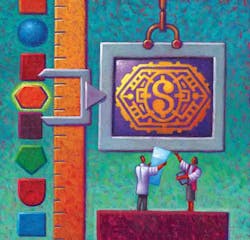“But the really interesting thing? If you go back to the plant three years later and ask ‘Did you get the ROI that you expected to get?’ usually you’ll hear, ‘I don’t know—I didn’t have time to measure that,’ ” Martin relates. “You can’t just throw an automation system in and expect financial gain. You’ve got to do proper planning,” agrees John Dolenc. To this principal consulting engineer with vendor Emerson Process Management’s (www.emersonprocess.com) Process Systems and Solutions Group, in Eden Praire, Minn. , that means finding the source of benefits before planning automation.That also means confronting the fact that some in manufacturing see automation as a cost, while others see it as a benefit. Two approaches help show that “if you put this [automation] in, you’ll get these results,” Dolenc says. One involves analyzing historical information. “Dig into data, look for variability that you can reduce. Find areas for improvement,” he advises. Reducing the calculated standard deviation is the goal. For example, the rule of thumb is to reduce standard deviation by 50 percent, Dolenc explains. “Then you back the numbers in and see if there’s an increase in production or quality.” By reducing variability, “you reset the set-point for optimum operations,” he adds.Best vs. averageThe other approach is the best-operator method. “You look at how a plant operated in the past and how it may have deviated from its [best operation],” Dolenc explains. “You look at the best vs. the average.” Using these methods iteratively—five times or more, Dolenc speculates—shows a gain, “and this is where the benefit derives. Once you’re there, you design the automation system to get those benefits,” he adds. And that, Dolenc notes, puts the project planners right in the middle of the conceptual engineering process. The next step? “I have benefits, because that’s where I started. Then you look at costs, then calculate ROI,” Dolenc explains. In calculating ROI, he uses the respective end-user’s method of calculating return—“their cost of money, or the discount; even their formula.” The calculation might be just net present value or ROI, he adds.But Paul Wenner, who’s no fan of ROI, uses a different approach to assess return on automation investments. “Total value is a systematic approach used to assess and validate overall business performance. It measures effectiveness of a supplier-customer partnership to convert projected value into actual value or benefit,” explains this manager, global original equipment manufacturers, at Rockwell Automation Inc. (www.rockwellautomation.com), in Milwaukee . Total value focuses on the broad view. “The purpose of total value is to add value to end-users to make their businesses successes,” Wenner explains. And using a total-value approach captures more than just total-cost considerations, he suggests. “It also captures performance advantages gained by end-users—for example, a brewing company—and their customers—for example, the public.” In this example, the supplier would use total value; the machine builder for making the aluminum cans would use total cost of ownership; and the brewing company would use ROI, Wenner explains.Martin observes that, unlike ROI, return calculated by the total-value method doesn’t stop at 100 percent. “It is more of a cash-flow analysis—you continue to make money on that approach.” Whatever method is used to calculate return, though, he believes industry faces this dilemma: “End-users tend to measure the cost without measuring the benefit. But from a financial perspective, if you didn’t measure the benefit, it (the benefit) didn’t happen.”C. Kenna Amos, [email protected], is an Automation World Contributing Editor
About the Author
C. Kenna Amos
Contributing Editor
Sign up for our eNewsletters
Get the latest news and updates

Leaders relevant to this article:
